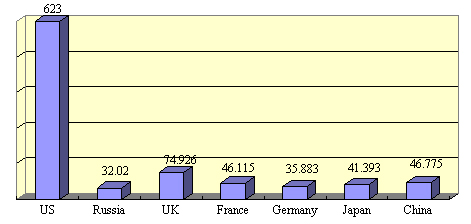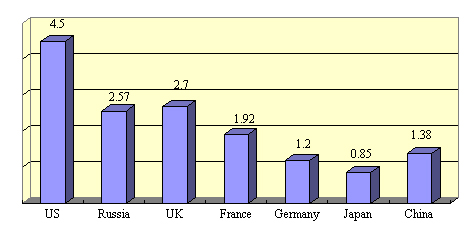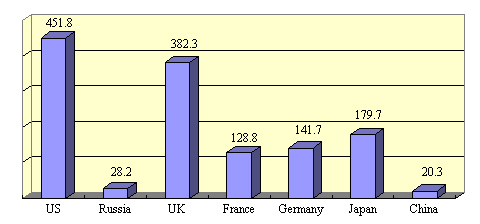XII. Defense Expenditure
Guided by the principle that defense expenditure should grow in line with the demands of national defense and economic development, the Chinese government decides on the size of defense expenditure in an appropriate way, and takes a road of national defense and armed forces modernization featuring lower cost and higher efficiency.
In the past three decades of reform and opening up, China has insisted that defense development should be both subordinated to and in the service of the country's overall economic development, and that the former should be coordinated with the latter. As a result, defense expenditure has always been kept at a reasonable and appropriate level. From 1978 to 1987, as the nation shifted its focus to economic development, national defense received a low input and was in a state of bare sustenance. During this period the average annual increase of defense expenditure was 3.5 percent, while that of GDP was 14.1 percent and that of the state financial expenditure was 10.4 percent. The shares of China's annual defense expenditure in its GDP and in the state financial expenditure dropped respectively from 4.6 percent and 14.96 percent in 1978 to 1.74 percent and 9.27 percent in 1987. From 1988 to 1997, to make up for the inadequacy of defense development and maintain national security and unity, China gradually increased its defense expenditure on the basis of its sustained economic growth. During this period the average annual increase of defense expenditure was 14.5 percent while that of GDP was 20.7 percent and that of the state financial expenditure was 15.1 percent. The shares of China's annual defense expenditure in its GDP and in the state financial expenditure continued to drop. From 1998 to 2007, to maintain national security and development and meet the requirements of the RMA with Chinese characteristics, China continued to increase its defense expenditure steadily on the basis of its rapid economic growth. During this period, the average annual increase of defense expenditure was 15.9 percent, while that of GDP was 12.5 percent and that of the state financial expenditure was 18.4 percent. Although the share of China's defense expenditure in its GDP increased, that in the state financial expenditure continued to drop on the whole.
China's GDP was RMB21,192.3 billion in 2006 and RMB25,730.6 billion in 2007. The state financial expenditure was RMB4,042.273 billion in 2006 and RMB4,978.135 billion in 2007, up 19.1 percent and 23.2 percent respectively over the previous year. China's defense expenditure was RMB297.938 billion in 2006 and RMB355.491 billion in 2007, up 20.4 percent and 19.3 percent respectively over the previous year. The shares of China's annual defense expenditure in its GDP and in the state financial expenditure in 2006 were roughly the same as those in 2007, being 1.41 percent and 7.37 percent in 2006 and 1.38 percent and 7.14 percent in 2007. China's defense expenditure mainly comprises expenses for personnel, training and maintenance, and equipment. Expenses for personnel and training and maintenance account for two thirds of the defense expenditure. In 2007, the defense expenditure was used to cover the expenses of the active force (RMB343.439 billion), the reserve force (RMB3.693 billion) and the militia (RMB8.359 billion). China's defense budget for 2008 is RMB417.769 billion.
Chart 1: China's Defense Expenditure in 2007 (unit: RMB billion)

Note: Personnel expenses mainly cover the salaries, allowances, food, bedding and clothing, insurance and welfare benefits for officers, NCOs, enlisted men and contracted civilians, as well as pension for the disabled or the family of the deceased. Training and maintenance expenses cover troop training, institutional education, construction and maintenance of various undertakings. Equipment expenses mainly cover R&D, experimentation, procurement, maintenance, transportation and storage of weaponry and equipment.
In the past two years, the increased part of China's defense expenditure has primarily been used for the following purposes: (1) Increasing the salaries and benefits of servicemen. Along with the rise of the income of civil servants and the living standards of both urban and rural residents, China has increased the relevant allowances and subsidies of servicemen to ensure the parallel improvement of their living standards. (2) Compensating for price rises. With the rise of the prices of food, building materials, fuel, etc., China has accordingly increased the boarding subsidies and other funds closely related to servicemen's life as well as the expenses on education, training, petroleum, oils and lubricants for the armed forces, and improved the working and living conditions of border and coastal defense forces, units in remote and tough areas, and grass-roots units. (3) Pushing forward the RMA. China has augmented the input into military informationization and moderately increased the funds for equipment and supporting facilities, so as to raise the defense capabilities in conditions of informationization.
Both the total amount and per-service-person share of China's defense expenditure remain lower than those of some major powers. In 2007 China's defense expenditure equaled 7.51 percent of that of the United States, 62.43 percent of that of the United Kingdom. China's defense expenses per service person amounted to 4.49 percent of that of the United States, 11.3 percent of that of Japan, 5.31 percent of that of the United Kingdom, 15.76 percent of that of France and 14.33 percent of that of Germany. As for the share of defense expenditure in GDP, that of China was merely 1.38 percent, while that of the United States was 4.5 percent, that of the United Kingdom 2.7 percent, and that of France 1.92 percent.
Chart 2: Comparison of Defense Expenditures of Some Countries in 2007 (unit: US$ billion)

Chart 3: Comparison of Percentages of Defense Expenditures in the GDP of Some Countries in 2007 (%)

Chart 4: Comparison of Per-Service-Person Share of Defense Expenditure of Some Countries in 2007 (unit: US$ 1,000)

The Chinese government has established defense expenditure reporting and publishing mechanisms. Since 1978 the Chinese government has submitted a financial budget report to the NPC and published the total amount of the defense budget each year. The relevant data of China's defense expenditure has been made public in the China Economy Yearbook since 1981, and in the China Finance Yearbook since 1992. And since 1995 the composition and main purposes of China's defense expenditure have been published in the form of government white papers.